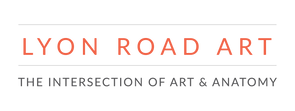Let’s you and I take a quick jaunt back to the Renaissance, shall we?
It’s there that the study of anatomy really takes off. While it’s anatomist and surgeon Andreas Vesalius (Fabric of the Human Body, 1543) that is considered the Father of Anatomy, it very well could’ve been Leonardo da Vinci, who began his anatomical drawings from cadaver dissections much earlier, around 1489. Not to take anything away from Vesalius, his work had an enormous impact on the medical field.
Leonardo (yes, I believe we’d be on a first-name basis if we ever got to hang out!) was obsessed with anatomy and it’s said that he claimed to have dissected over 30 cadavers by the end of his life! His notebook “Anatomical Manuscript A” holds over 240 illustrations and more than 13,000 words describing his findings on the function of the human body. Had Leonardo published his findings, we may have in fact called him the Father of Anatomy, and may even have had more insight about ourselves sooner. He was the first to show an accurate depiction of the spine and incredibly, one of his ideas regarding the function of the heart, the function of the aortic valve specifically, wasn't discovered (or re-discovered) until 500 years later by two engineers at Oxford University! Being the curious problem solver he was, Leonardo filled a bovine heart with wax and then made a model of it in glass from the wax mold. He poured a mixture of water and grass seed through the valves to watch how the liquid moved through them, leading him to correctly posit that the small vortices that developed from the movement helped close the aortic valve in order to maintain blood flow in one direction. Again, it took 500 years and technologies he couldn’t have dreamed of to make the same discovery. Amazing.
Art, anatomy, and the intersection of the two
While Leonardo is by far one of the most influential Renaissance Men, there were actually many artists that studied anatomy and even performed cadaver dissections during this time. Artists during the Renaissance strived to create incredibly realistic portrayals of the human body so naturally, they had to be well versed in anatomical structures and their functions.
If you think that the practice of artists taking part in cadaver labs lies in the days of yore, you’d be dead wrong (pun intended). While I was in school, I took part in cadaver labs, and although gross, I can say it was a profound experience for me. It’s simply astounding that internally, we look so messy and chaotic, yet the processes that have to work in unison in order for us to function are so intricate and beautiful. That’s what drives me to try to fill the gap, to take the messy and chaotic and try to present it in a way that shows the intricacies and beauty that makes us tick, makes us special, and makes us who we are.
What is anatomy art really?

That’s a great question because while anatomy and art have always, inextricably been linked, there are nuanced differences that can be pointed out within types of anatomy art. Anatomy art can be the illustrations in textbooks for learning purposes. While still artistic and beautiful, there is a specific scientific purpose, and the more detailed and precise, the greater the value. While different in application, there are also sculptures and computer-generated models that serve as educational tools. The other side of anatomy art is the more fine art approach. My love of fine art didn’t dwindle after starting down my pre-med path, in fact, it made me miss it even more. But to give up on medicine would’ve left me wanting too. I found my new path in anatomy art, I think it’s what I always wanted but never knew was possible. I still thank the google gods for serving me up the perfect results to my “art and medicine career” query when at my crossroads. My anatomy art style allows me to be inspired by anatomy but not restricted by it. I love creating imagery that looks abstract, where you intuitively cock your head and say “I know what this is, I just can’t quite put my finger on it.” A perfect example of this would be my Organ of Corti painting in which I flip it on its side and mirror it on itself. The beautiful structure is there, but it’s not immediately recognizable. It could easily hang above a couch in a home setting and most people would have no idea that it’s anatomy-focused art. While I also love anatomically accurate and specific pieces, the abstract ones are my favorite.
Anatomy art is many things and its history long. I hope to continue to push the boundaries of what it can be and contribute to its future. My hope is also that you continue on this journey with me!
If you want to know more
Last November, Kali and I actually did a 2 part podcast covering a bit more information on Medical Illustration Through the Ages. Check it out for more detailed info!
PART ONE:
PART TWO:
And you can find all our podcast episodes here! >



